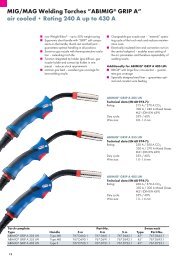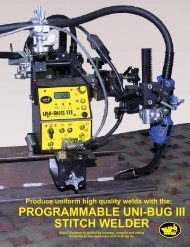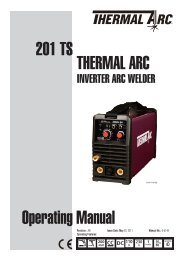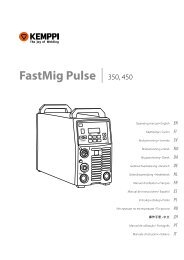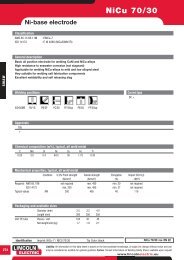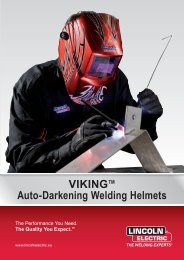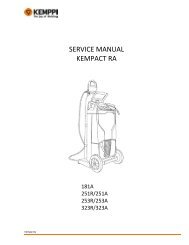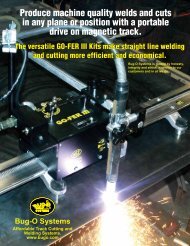125, 140, 180 models - Rapid Welding and Industrial Supplies Ltd
125, 140, 180 models - Rapid Welding and Industrial Supplies Ltd
125, 140, 180 models - Rapid Welding and Industrial Supplies Ltd
Create successful ePaper yourself
Turn your PDF publications into a flip-book with our unique Google optimized e-Paper software.
iDiesel engine exhaust <strong>and</strong> some of its constituentsare known to the State of California to cause cancer,birth defects, <strong>and</strong> other reproductive harm.The Above For Diesel EnginesFOR ENGINEpowered equipment.1.a. Turn the engine off before troubleshooting <strong>and</strong> maintenancework unless the maintenance work requires it to be running.____________________________________________________1.b. Operate engines in open, well-ventilatedareas or vent the engine exhaust fumesoutdoors.____________________________________________________1.c. Do not add the fuel near an open flamewelding arc or when the engine is running.Stop the engine <strong>and</strong> allow it to cool beforerefueling to prevent spilled fuel from vaporizingon contact with hot engine parts <strong>and</strong>igniting. Do not spill fuel when filling tank. Iffuel is spilled, wipe it up <strong>and</strong> do not startengine until fumes have been eliminated.____________________________________________________1.d. Keep all equipment safety guards, covers <strong>and</strong> devices inposition <strong>and</strong> in good repair.Keep h<strong>and</strong>s, hair, clothing <strong>and</strong>tools away from V-belts, gears, fans <strong>and</strong> all other movingparts when starting, operating or repairing equipment.____________________________________________________1.e. In some cases it may be necessary to remove safetyguards to perform required maintenance. Removeguards only when necessary <strong>and</strong> replace them when themaintenance requiring their removal is complete.Always use the greatest care when working near movingparts.___________________________________________________1.f. Do not put your h<strong>and</strong>s near the engine fan.Do not attempt to override the governor oridler by pushing on the throttle control rodswhile the engine is running.SAFETYWARNINGCALIFORNIA PROPOSITION 65 WARNINGSThe engine exhaust from this product containschemicals known to the State of California to causecancer, birth defects, or other reproductive harm.The Above For Gasoline EnginesARC WELDING CAN BE HAZARDOUS. PROTECT YOURSELF AND OTHERS FROM POSSIBLE SERIOUS INJURY OR DEATH.KEEP CHILDREN AWAY. PACEMAKER WEARERS SHOULD CONSULT WITH THEIR DOCTOR BEFORE OPERATING.Read <strong>and</strong> underst<strong>and</strong> the following safety highlights. For additional safety information, it is strongly recommended that youpurchase a copy of “Safety in <strong>Welding</strong> & Cutting - ANSI St<strong>and</strong>ard Z49.1” from the American <strong>Welding</strong> Society, P.O. Box351040, Miami, Florida 33135 or CSA St<strong>and</strong>ard W117.2-1974. A Free copy of “Arc <strong>Welding</strong> Safety” booklet E205 is availablefrom the Lincoln Electric Company, 22801 St. Clair Avenue, Clevel<strong>and</strong>, Ohio 44117-1199.BE SURE THAT ALL INSTALLATION, OPERATION, MAINTENANCE AND REPAIR PROCEDURES AREPERFORMED ONLY BY QUALIFIED INDIVIDUALS.1.h. To avoid scalding, do not remove theradiator pressure cap when the engine ishot.ELECTRIC ANDMAGNETIC FIELDSmay be dangerous2.a. Electric current flowing through any conductor causeslocalized Electric <strong>and</strong> Magnetic Fields (EMF). <strong>Welding</strong>current creates EMF fields around welding cables <strong>and</strong>welding machines2.b. EMF fields may interfere with some pacemakers, <strong>and</strong>welders having a pacemaker should consult their physicianbefore welding.2.c. Exposure to EMF fields in welding may have other healtheffects which are now not known.2.d. All welders should use the following procedures in order tominimize exposure to EMF fields from the welding circuit:2.d.1. Route the electrode <strong>and</strong> work cables together - Securethem with tape when possible.2.d.2. Never coil the electrode lead around your body.2.d.3. Do not place your body between the electrode <strong>and</strong>work cables. If the electrode cable is on your rightside, the work cable should also be on your right side.i___________________________________________________1.g. To prevent accidentally starting gasoline engines whileturning the engine or welding generator during maintenancework, disconnect the spark plug wires, distributor cap ormagneto wire as appropriate.2.d.4. Connect the work cable to the workpiece as close aspossible to the area being welded.2.d.5. Do not work next to welding power source.
iiELECTRIC SHOCK cankill.3.a. The electrode <strong>and</strong> work (or ground) circuitsare electrically “hot” when the welder is on.Do not touch these “hot” parts with your bareskin or wet clothing. Wear dry, hole-freegloves to insulate h<strong>and</strong>s.3.b. Insulate yourself from work <strong>and</strong> ground using dry insulation.Make certain the insulation is large enough to cover your fullarea of physical contact with work <strong>and</strong> ground.In addition to the normal safety precautions, if weldingmust be performed under electrically hazardousconditions (in damp locations or while wearing wetclothing; on metal structures such as floors, gratings orscaffolds; when in cramped positions such as sitting,kneeling or lying, if there is a high risk of unavoidable oraccidental contact with the workpiece or ground) usethe following equipment:• Semiautomatic DC Constant Voltage (Wire) Welder.• DC Manual (Stick) Welder.• AC Welder with Reduced Voltage Control.3.c. In semiautomatic or automatic wire welding, the electrode,electrode reel, welding head, nozzle or semiautomaticwelding gun are also electrically “hot”.3.d. Always be sure the work cable makes a good electricalconnection with the metal being welded. The connectionshould be as close as possible to the area being welded.3.e. Ground the work or metal to be welded to a good electrical(earth) ground.3.f.Maintain the electrode holder, work clamp, welding cable <strong>and</strong>welding machine in good, safe operating condition. Replacedamaged insulation.3.g. Never dip the electrode in water for cooling.3.h. Never simultaneously touch electrically “hot” parts ofelectrode holders connected to two welders because voltagebetween the two can be the total of the open circuit voltageof both welders.3.i.When working above floor level, use a safety belt to protectyourself from a fall should you get a shock.3.j. Also see Items 6.c. <strong>and</strong> 8.SAFETYARC RAYS can burn.4.a. Use a shield with the proper filter <strong>and</strong> coverplates to protect your eyes from sparks <strong>and</strong>the rays of the arc when welding or observingopen arc welding. Headshield <strong>and</strong> filter lensshould conform to ANSI Z87. I st<strong>and</strong>ards.4.b. Use suitable clothing made from durable flame-resistantmaterial to protect your skin <strong>and</strong> that of your helpers fromthe arc rays.4.c. Protect other nearby personnel with suitable, non-flammablescreening <strong>and</strong>/or warn them not to watch the arc nor exposethemselves to the arc rays or to hot spatter or metal.FUMES AND GASEScan be dangerous.5.a. <strong>Welding</strong> may produce fumes <strong>and</strong> gaseshazardous to health. Avoid breathing thesefumes <strong>and</strong> gases. When welding, keepyour head out of the fume. Use enoughventilation <strong>and</strong>/or exhaust at the arc to keepfumes <strong>and</strong> gases away from the breathing zone. Whenwelding with electrodes which require specialventilation such as stainless or hard facing (seeinstructions on container or MSDS) or on lead orcadmium plated steel <strong>and</strong> other metals or coatingswhich produce highly toxic fumes, keep exposure aslow as possible <strong>and</strong> within applicable OSHA PEL <strong>and</strong>ACGIH TLV limits using local exhaust or mechanicalventilation. In confined spaces or in some circumstances,outdoors, a respirator may be required.Additional precautions are also required when weldingon galvanized steel.5. b. The operation of welding fume control equipment is affectedby various factors including proper use <strong>and</strong> positioning ofthe equipment, maintenance of the equipment <strong>and</strong> the specificwelding procedure <strong>and</strong> application involved. Workerexposure level should be checked upon installation <strong>and</strong>periodically thereafter to be certain it is within applicableOSHA PEL <strong>and</strong> ACGIH TLV limits.5.c. Do not weld in locations near chlorinated hydrocarbon vaporscoming from degreasing, cleaning or spraying operations.The heat <strong>and</strong> rays of the arc can react with solvent vapors toform phosgene, a highly toxic gas, <strong>and</strong> other irritating products.5.d. Shielding gases used for arc welding can displace air <strong>and</strong>cause injury or death. Always use enough ventilation,especially in confined areas, to insure breathing air is safe.iiOPERATORʼS MANUAL5.e. Read <strong>and</strong> underst<strong>and</strong> the manufacturer’s instructions for thisequipment <strong>and</strong> the consumables to be used, including thematerial safety data sheet (MSDS) <strong>and</strong> follow youremployer’s safety practices. MSDS forms are available fromyour welding distributor or from the manufacturer.5.f.Also see item 1.b.
iiiSAFETYiiiWELDING <strong>and</strong> CUTTINGSPARKS cancause fire or explosion.6.a. Remove fire hazards from the welding area.If this is not possible, cover them to preventthe welding sparks from starting a fire.Remember that welding sparks <strong>and</strong> hotmaterials from welding can easily go through small cracks<strong>and</strong> openings to adjacent areas. Avoid welding nearhydraulic lines. Have a fire extinguisher readily available.6.b. Where compressed gases are to be used at the job site,special precautions should be used to prevent hazardoussituations. Refer to “Safety in <strong>Welding</strong> <strong>and</strong> Cutting” (ANSISt<strong>and</strong>ard Z49.1) <strong>and</strong> the operating information for theequipment being used.6.c. When not welding, make certain no part of the electrodecircuit is touching the work or ground. Accidental contactcan cause overheating <strong>and</strong> create a fire hazard.6.d. Do not heat, cut or weld tanks, drums or containers until theproper steps have been taken to insure that such procedureswill not cause flammable or toxic vapors from substancesinside. They can cause an explosion even though they havebeen “cleaned”. For information, purchase “RecommendedSafe Practices for the Preparation for <strong>Welding</strong> <strong>and</strong> Cutting ofContainers <strong>and</strong> Piping That Have Held HazardousSubstances”, AWS F4.1 from the American <strong>Welding</strong> Society(see address above).6.e. Vent hollow castings or containers before heating, cutting orwelding. They may explode.6.f. Sparks <strong>and</strong> spatter are thrown from the welding arc. Wear oilfree protective garments such as leather gloves, heavy shirt,cuffless trousers, high shoes <strong>and</strong> a cap over your hair. Wearear plugs when welding out of position or in confined places.Always wear safety glasses with side shields when in awelding area.6.g. Connect the work cable to the work as close to the weldingarea as practical. Work cables connected to the buildingframework or other locations away from the welding areaincrease the possibility of the welding current passingthrough lifting chains, crane cables or other alternate circuits.This can create fire hazards or overheat lifting chainsor cables until they fail.6.h. Also see item 1.c.CYLINDER may explodeif damaged.7.a. Use only compressed gas cylinderscontaining the correct shielding gas for theprocess used <strong>and</strong> properly operatingregulators designed for the gas <strong>and</strong>pressure used. All hoses, fittings, etc. should be suitable forthe application <strong>and</strong> maintained in good condition.7.b. Always keep cylinders in an upright position securelychained to an undercarriage or fixed support.7.c. Cylinders should be located:• Away from areas where they may be struck or subjected tophysical damage.• A safe distance from arc welding or cutting operations <strong>and</strong>any other source of heat, sparks, or flame.7.d. Never allow the electrode, electrode holder or any otherelectrically “hot” parts to touch a cylinder.7.e. Keep your head <strong>and</strong> face away from the cylinder valve outletwhen opening the cylinder valve.7.f.Valve protection caps should always be in place <strong>and</strong> h<strong>and</strong>tight except when the cylinder is in use or connected foruse.7.g. Read <strong>and</strong> follow the instructions on compressed gascylinders, associated equipment, <strong>and</strong> CGA publication P-l,“Precautions for Safe H<strong>and</strong>ling of Compressed Gases inCylinders,” available from the Compressed Gas Association1235 Jefferson Davis Highway, Arlington, VA 22202.FOR ELECTRICALLYpowered equipment.8.a. Turn off input power using the disconnectswitch at the fuse box before working onthe equipment.8.b. Install equipment in accordance with the U.S. NationalElectrical Code, all local codes <strong>and</strong> the manufacturer’srecommendations.8.c. Ground the equipment in accordance with the U.S. NationalElectrical Code <strong>and</strong> the manufacturer’s recommendations.6.I. Read <strong>and</strong> follow NFPA 51B “ St<strong>and</strong>ard for Fire PreventionDuring <strong>Welding</strong>, Cutting <strong>and</strong> Other Hot Work”, availablefrom NFPA, 1 Batterymarch Park, PO box 9101, Quincy, Ma022690-9101.6.j.Do not use a welding power source for pipe thawing.Refer to http://www.lincolnelectric.com/safety for additional safety information.
NOTESOPERATORʼS MANUAL
ivThank Youfor selecting a QUALITY product by Lincoln Electric. We want youto take pride in operating this Lincoln Electric Company product••• as much pride as we have in bringing this product to you!ivCUSTOMER ASSISTANCE POLICYThe business of The Lincoln Electric Company is manufacturing <strong>and</strong> selling high quality welding equipment, consumables, <strong>and</strong> cutting equipment.Our challenge is to meet the needs of our customers <strong>and</strong> to exceed their expectations. On occasion, purchasers may ask LincolnElectric for advice or information about their use of our products. We respond to our customers based on the best information in our possessionat that time. Lincoln Electric is not in a position to warrant or guarantee such advice, <strong>and</strong> assumes no liability, with respect to such informationor advice. We expressly disclaim any warranty of any kind, including any warranty of fitness for any customerʼs particular purpose,with respect to such information or advice. As a matter of practical consideration, we also cannot assume any responsibility for updating orcorrecting any such information or advice once it has been given, nor does the provision of information or advice create, exp<strong>and</strong> or alter anywarranty with respect to the sale of our products.Lincoln Electric is a responsive manufacturer, but the selection <strong>and</strong> use of specific products sold by Lincoln Electric is solely within the controlof, <strong>and</strong> remains the sole responsibility of the customer. Many variables beyond the control of Lincoln Electric affect the results obtained inapplying these types of fabrication methods <strong>and</strong> service requirements.Subject to Change – This information is accurate to the best of our knowledge at the time of printing. Please refer to www.lincolnelectric.comfor any updated information.Please Examine Carton <strong>and</strong> Equipment For Damage ImmediatelyWhen this equipment is shipped, title passes to the purchaser upon receipt by the carrier. Consequently, Claimsfor material damaged in shipment must be made by the purchaser against the transportation company at thetime the shipment is received.Please record your equipment identification information below for future reference. This information can befound on your machine nameplate.Product _________________________________________________________________________________Model Number ___________________________________________________________________________Code Number or Date Code_________________________________________________________________Serial Number____________________________________________________________________________Date Purchased___________________________________________________________________________Where Purchased_________________________________________________________________________Whenever you request replacement parts or information on this equipment, always supply the information youhave recorded above. The code number is especially important when identifying the correct replacement parts.On-Line Product Registration- Register your machine with Lincoln Electric either via fax or over the Internet.• For faxing: Complete the form on the back of the warranty statement included in the literature packetaccompanying this machine <strong>and</strong> fax the form per the instructions printed on it.• For On-Line Registration: Go to our WEB SITE at www.lincolnelectric.com. Choose “Quick Links” <strong>and</strong> then“Product Registration”. Please complete the form <strong>and</strong> submit your registration.Read this Operators Manual completely before attempting to use this equipment. Save this manual <strong>and</strong> keep ith<strong>and</strong>y for quick reference. Pay particular attention to the safety instructions we have provided for your protection.The level of seriousness to be applied to each is explained below:WARNINGThis statement appears where the information must be followed exactly to avoid serious personal injury or loss of life.CAUTIONThis statement appears where the information must be followed to avoid minor personal injury or damage to this equipment.
A-1TECHNICAL SPECIFICATIONSINSTALLATIONA-1<strong>180</strong> Amp units (K2481-1, K2515-1, K2659-1, K2689-1, K2698-1)INPUT – SINGLE PHASE ONLYSt<strong>and</strong>ard Voltage/FrequencyInput Current230 V 60 Hz 20 Amps @ rated output208 V 60 Hz 20 Amps @ rated outputVoltage/Duty CycleRATED OUTPUTCurrent Voltage at Rated Amperes230 V 30% 130 Amps 20208 V 30% 130 Amps 17OUTPUT<strong>Welding</strong> Current Range Open Circuit Voltage Wire Speed Range30-<strong>180</strong> Amps 34 V 50 - 500 in/min.(1.3 - 12.7 m/min.)RECOMMENDED INPUT CABLE AND FUSE SIZESInput Voltage/Frequency Fuse or Breaker Size 1 Input Amps Power Cord230 V 60 Hz 40 Amp Super Lag 20 50 Amp, 250 V,Three Prong Plug(NEMA Type 6-50P)PHYSICAL DIMENSIONSHeight Width Depth Weight13.7 in 10.15 in 17.9 in 64 Ibs347 mm 258 mm 454 mm 29 kgOPERATORʼS MANUAL1 If connected to a circuit protected by fuses use Time Delay Fuse marked “D”.<strong>140</strong> Amp units (K2480-1, K2514-1, K2658-1, K2688-1, K2697-1)INPUT – SINGLE PHASE ONLYSt<strong>and</strong>ard Voltage/FrequencyInput Current120 V / 60 Hz 20 Amps @ rated outputRATED OUTPUTDuty Cycle Current Voltage at Rated Amperes20% Duty Cycle 90 Amps 19.5OUTPUT<strong>Welding</strong> Current Range Open Circuit Voltage Wire Speed Range30-<strong>140</strong> Amps 33 V 50 - 500 in/min.(1.3 - 12.7 m/min.)RECOMMENDED INPUT CABLE AND FUSE SIZESInput Voltage/Frequency Fuse or Breaker Size 1,2 Input Amps Power Cord Extension Cord120 V 60 Hz 20 Amp 20 15 Amp, <strong>125</strong> V, 3 Conductor # 12 AWGThree Prong Plug (4mm 2 ) or Larger(NEMA Type 5-15P) up to 50 ft.(15.2m)PHYSICAL DIMENSIONSHeight Width Depth Weight13.7 in 10.15 in 17.9 in 54 Ibs347 mm 258 mm 454 mm 24.5 kg1If connected to a circuit protected by fuses use Time Delay Fuse marked “D”.WIRE FEEDER WELDERS (<strong>125</strong>, <strong>140</strong>, <strong>180</strong> MODELS)
A-2INSTALLATIONTECHNICAL SPECIFICATIONS <strong>125</strong> Amp units (K2479-1, K2513-1, K2696-1, K2699-1, K2785-1)INPUT – SINGLE PHASE ONLYSt<strong>and</strong>ard Voltage/Frequency Input Current120 V / 60 Hz 20 Amps @ rated outputRATED OUTPUTDuty Cycle Current Voltage at Rated Amperes20% Duty Cycle 90 Amps 19OUTPUT<strong>Welding</strong> Current Range Maximum-Open Circuit Voltage Wire Speed Range30-<strong>125</strong> Amps 33 V 50 - 500 in/min.(1.3 - 12.7 m/min.)RECOMMENDED INPUT CABLE AND FUSE SIZESInput Voltage / Frequency Fuse or Breaker Size 1,2 Input Amps Power Cord Extension Cord120 V 60 Hz 20 Amp 20 15 Amp, <strong>125</strong> V, 3 Conductor # 12 AWGThree Prong Plug (4mm 2 ) or Larger(NEMA Type 5-15P) up to 50 ft.(15.2m)PHYSICAL DIMENSIONSHeight Width Depth Weight13.7 in 10.15 in 17.9 in 48 Ibs347 mm 258 mm 454 mm 21.7 kg1 If connected to a circuit protected by fuses use Time Delay Fuse marked “D”.2 Requirements For Maximum OutputIn order to utilize the maximum output capability ofthe machine, a branch circuit capable of 25 amps at120 volts, 60 Hertz is required.A-2Read entire installation section before startinginstallation.SAFETY PRECAUTIONSWARNINGELECTRIC SHOCK can kill.• Only qualified personnel should performthis installation.• Only personnel that have read <strong>and</strong> understoodthe POWER MIG Operating Manualshould install <strong>and</strong> operate this equipment.• Machine must be plugged into a receptaclewhich is grounded per any national, localor other applicable electrical codes.• The POWER MIG power switch is to be inthe OFF (“O”) position when installingwork cable <strong>and</strong> gun <strong>and</strong> when connectingpower cord to input power.SELECT SUITABLE LOCATIONLocate the welder in a dry location where there is freecirculation of clean air into the louvers in the back <strong>and</strong>out the front of the unit. A location that minimizes theamount of smoke <strong>and</strong> dirt drawn into the rear louversreduces the chance of dirt accumulation that canblock air passages <strong>and</strong> cause overheating.STACKINGWIRE FEEDER WELDER(<strong>125</strong>, <strong>140</strong>, <strong>180</strong> MODELS)cannot be stacked.TILTINGEach machine must be placed on a secure, level surface,directly or on recommended cart. The machinemay topple over if this procedure is not followed.WIRE FEEDER WELDERS (<strong>125</strong>, <strong>140</strong>, <strong>180</strong> MODELS)
®®A-3IDENTIFY AND LOCATECOMPONENTSfor <strong>140</strong> AMP <strong>and</strong> <strong>180</strong> AMP UNITSINSTALLATION•H<strong>and</strong>shield*LINCOLNELECTRIC• Magnum 100L <strong>Welding</strong> Gun.A-3INCLUDED COMPONENTS• Wire FeederWelder.• Work Cable & Clamp.• Magnum 100L <strong>Welding</strong> Gun.• 3 .035 Contact Tips (1 installedon the welding gun).• 3 .025 Contact Tips.*H<strong>and</strong>shield not available on Code 11658.• Black Flux-cored Gasless GunNozzle (Installed on <strong>Welding</strong>Gun)• Brass MIG Gas Gun Nozzle• 2” Spindle Adapter (For 8” Reel ofwire)• Regulator• Gas Hose• Learn to Weld (LTW1 Manual)• DVDREGULATOR2" SPINDLE ADAPTER (FOR 8" REEL OF WIRE)• 3 .035 Contact Tips (1 installed onthe welding gun).• Spool of .035 diameter NR-211MP Innershield Flux-coredWire.• .030 -.045 Knurled Drive Roll(Installed onMachine)• H<strong>and</strong>shield.035.035 NR-211 MPFLUX-CORED WIR ELINCOLNELECTRIC.035OPERATORʼS MANUALGAS HOSELTW1"LEARN TO WELD"• Spool of .035 diameter NR-211MP Innershield Flux-coredWire.• Spool of .025 diameter L-56 MIGWire.DVD• Black Flux-cored Gasless GunNozzle (Installed on <strong>Welding</strong> Gun)NR-211 MPL-56 MIG• .025-.030 Smooth Drive Roll• .035 Smooth Drive RollWIREIDENTIFY AND LOCATECOMPONENTSfor <strong>125</strong> AMP FLUX CORE UNIT• INCLUDED COMPONENTS• Wire FeederWelder.• 2” Spindle Adapter (For 8” Reel ofwire)• Learn to Weld (LTW1 Manual)• DVD2" SPINDLE ADAPTER (FOR 8" REEL OF WIRE)LTW1"LEARN TO WELD"• .030 -.045 KnurledDrive Roll(Installed onMachine)• Work Cable & Clamp.DVDWIRE FEEDER WELDERS (<strong>125</strong>, <strong>140</strong>, <strong>180</strong> MODELS)
B-1OPERATIONB-1Read entire operation section beforeoperating the WIRE FEEDER WELDERS.WARNINGELECTRIC SHOCK can kill.• Do not touch electrically liveparts or electrode with skin orwet clothing. Insulate yourselffrom work <strong>and</strong> ground.• Always wear dry insulatinggloves.FUMES AND GASES can bedangerous.• Keep your head out of fumes.• Use ventilation or exhaust toremove fumes from breathingzone.WELDING SPARKS cancause fire or explosion.• Keep flammable material away.• Do not weld on closed containers.ARC RAYS can burn eyes<strong>and</strong> skin.• Wear eye, ear <strong>and</strong> body protection.PRODUCT DESCRIPTION (PRODUCTCAPABILITIES)These small portable wire feed welders are capable ofMIG welding on steel, stainless steel, <strong>and</strong> aluminum.They are also capable of flux-cored welding on mildsteel.MIG welding st<strong>and</strong>s for Metal Inert Gas welding <strong>and</strong>requires a separate bottle of shielding gas to protectthe weld until it cools. Appropriate shielding gasbased on the type of material you are welding can bepurchased separately from your local welding gas distributor.MIG welding is ideal for welding on thinner<strong>and</strong> clean materials when a very clean excellent cosmeticlooking weld is required. An example would beautomotive body panels.Self Sheilding Flux-cored <strong>Welding</strong> does not requireseparate shielding gas to protect the weld since thewelding wire has special additives known as flux toprotect the weld until it cools. Flux-cored welding isideal for medium to thicker material <strong>and</strong> if welding onpainted or rusty steel. Flux-cored welding is also idealin outdoor applications where windy conditions mightblow the MIG shielding gas away from the weld. Fluxcoredwelding produces a good looking weld but doesnot produce an excellent weld appearance as MIGwelding does.Your machine includes the necessary items to weldwith either the MIG or the flux-cored welding processon steel. To weld on stainless steel optional stainlesssteel welding wire can be purchased separately. Thismachine can weld aluminum using .035 diameter4043 aluminum welding wire. Since aluminum weldingwire is soft an optional aluminum spool gun is recommendedfor best results. A welding ProcedureDecal is located inside machine door to help providesuggested settings for welding.Observe all safety information throughoutthis manual.------------------------------------------------------------COMMON WELDING ABBREVIATIONSGMAW (MIG)• Gas Metal Arc <strong>Welding</strong>FCAW (Innershield or Outershield)• Flux Core Arc <strong>Welding</strong>WIRE FEEDER WELDERS (<strong>125</strong>, <strong>140</strong>, <strong>180</strong> MODELS)
B-2CONTROLS AND SETTINGSThis machine has the following controls:OPERATIONB-2See Figure B.1FIGURE B.11. POWER SWITCH – Turns power on <strong>and</strong> off to themachine.2. ARC VOLTAGE CONTROL – This knob sets theoutput voltage of the machine. Along with wire feedspeed (WFS) this control sets a weld procedure.Refer to the procedure decal on the inside wiredrive compartment door to set a correct weldingprocedure based on type of material <strong>and</strong> thicknessbeing welded.3. WIRE FEED SPEED CONTROL (WFS) – The knobsets the speed that the machine feeds wire. Alongwith arc voltage this control sets a weld procedure.Refer to the procedure decal on the inside wiredrive compartment door to set a correct weldingprocedure based on type of material <strong>and</strong> thicknessbeing welded.312OPERATORʼS MANUALSee Figure B.2FIGURE B.24. GUN TRIGGER – Depress the trigger to activatesthe wire drive to feed wire <strong>and</strong> energizes the outputof the machine. Depress the trigger to weld <strong>and</strong>release the trigger to stop welding.5. WELDING GUN – Delivers wire <strong>and</strong> welding currentto the weld.a. Gun Liner – wire travels through the liner fromthe wire drive. The gun liner will feed .025 to .035wire. The <strong>180</strong>A machine can weld with .045 wireif an optional .045 liner is installed in the gun.5c5b5a5.035"(0.9mm)NR-211-MPWIRE SPOOLb. Contact Tip – provides electrical contact to thewire.c. Nozzle – When flux-cored welding the black nozzleprotects the mounting threads on the gun.When MIG welding the brass nozzle funnels theshielding gas to the weld.46 76. WORK CLAMP & CABLE – Clamps to the workpiece being welded <strong>and</strong> completes the electricalwelding circuit.7. GUN TRIGGER CONNECTOR RECEPTACLE –Plug the 4 pin gun trigger connector into this receptacle.WIRE FEEDER WELDERS (<strong>125</strong>, <strong>140</strong>, <strong>180</strong> MODELS)
B-3OPERATIONB-3See Figure B.3FIGURE B.38. WELDING GUN CONNECTOR BUSHING &THUMBSCREW – Provides electrical power to thewelding gun. The thumbscrew holds the weldinggun into the connector block. (Front of Machine,Side Door <strong>and</strong> Wire Drive Cover have beenremoved for clarity of Items 8 <strong>and</strong> 9).9. OUTPUT TERMINALS –These connections allowto change the welding polarity of the machinedepending on whether you are MIG welding or fluxcoredwelding.89See Figure B.4FIGURE B.410. WIRE SPOOL SPINDLE AND BRAKE – Holds a4 inch diameter spool. Use the 2 inch spindleadapter included with the machine to use 8 inchdiameter spools. The thumbscrew sets the brakefriction to prevent the spool from over rotatingwhen the trigger is released.See Figure B.511. WIRE DRIVE & COMPONENTS – Feeds wirefrom the wire spool through the drive <strong>and</strong> throughthe welding gun to the weld.a. Drive Roll – Drives the wire through the drivesystem. The drive roll has a groove to matchthe specific wire type <strong>and</strong> diameter. Refer toTable B.1 for available drive rolls.b. Liner & Outgoing Guide – The liner guides thewire between the bearing on the Pivot ArmAssembly <strong>and</strong> Drive Roll <strong>and</strong> through the outgoingguide.c. Drive Roll Tension Thumbscrew – Turningclockwise increases the force on the drive roll<strong>and</strong> turning counterclockwise decreases theforce.FIGURE B.5PIVOT ARM ASSEMBLYBEARINGOUTGOING GUIDETENSION ARM ASSEMBLYLINERDRIVE ROLLWIRE SPOOL.035" (0.9mm)NR-211-MPWIRE FEEDER WELDERS (<strong>125</strong>, <strong>140</strong>, <strong>180</strong> MODELS)
B-4OPERATIONTABLE B.1DRIVE ROLLSB-4Wire Diameter &TypeDrive RollDrive Roll PartNumber.025 MIG wire.030 MIG wire.035 MIG wire.030 flux-cored.035 flux-cored.045 flux-coredSee Figure B.6.025/.030 Smooth Drive Roll KP2529-1.035 Smooth Drive Roll KP2529-2.030/.045 Knurled Drive Roll KP2529-3.030/.045 Knurled Drive Roll KP2529-3FIGURE B.612 13OPERATORʼS MANUAL12. CIRCUIT BREAKER – If the rated input current ofthe machine is exceeded this circuit breaker willtrip. Press to reset.A. ITEMS NEEDED FORFLUX CORED WELDINGSETTING UP AND MAKING A FLUX-CORED WELD1. 035 Contact Tip3. .035 NR-211MP Flux-Cored Wire5. <strong>Welding</strong> Gun.03513. GAS INLET –Shielding gas connects to this inlet(This is optional on <strong>125</strong> Amp Unit.).035 NR-211 MPFLUX-CORED WIR E2. Knurled Drive Roll4. Black Flux Cored gun nozzle7. Work Cable & ClampWIRE FEEDER WELDERS (<strong>125</strong>, <strong>140</strong>, <strong>180</strong> MODELS)
B-5B. CONNECT LEADS AND CABLES ONTHE MACHINE(See Figure B.7)1. Open the case side doorOPERATIONFIGURE B.7B-52. Slide the connector end of the gun <strong>and</strong> cablethrough the hole in the machine front <strong>and</strong> into thegun connector bushing on the wire drive.3. Make sure the gun connector end is seated fullyinto the wire drive <strong>and</strong> tighten the molded h<strong>and</strong>screw to secure the gun connector.4. Plug the gun trigger lead connector into the 4 pingun trigger receptacle on the machine front.SLIDECONNECTOREND HERE(4 PIN)LEAD CONNECTORGUN AND CABLETERMINAL END(FITS ON STUD INSIDESEE FIGURE BELOW)WORK CLAMPOPEN LATCH DOORALL COMPONENTS SHOWN CONNECTED(FRONT AND SIDE DOOR IS REMOVEDFOR CLARITY)5. Wire Drive Polarity. Flux cored welding requiresnegative (-) polarity. Connect the short powercable from the wire drive to the negative (-) outputterminal <strong>and</strong> tighten threaded knob.6. Work Lead Connection. Slide the lugged end ofthe work cable through the hole in the machinefront <strong>and</strong> place on the positive (+) output terminal<strong>and</strong> tighten threaded knob.C. LOAD WIRE SPOOL(See Figure B.8)1. Locate the blue labeled 4" diameter spool of .035NR-211MP flux-cored wire <strong>and</strong> place onto wirespool spindle. Orient the spool so that the wirefeeds off the top of the spool.MOLDED HAND SCREW TOTIGHTEN CONNECTORBUSHINGCONNECTOREND ATTACH(4 PIN)TRIGGER RECEPTACLEPLUGGED INWORK CLAMPFIGURE B.8SHORT POWERCABLE NEGATIVE "-"OUTPUT TERMINALWORK LEADCONNECTIONPOSITIVE "+"OUTPUT TERMINAL2. Secure spool in place by tightening the wing nutagainst the against the spacer that holds the wirespool on the spindle.3. Open the pivot arm assembly by rotating the tensionarm assembly down <strong>and</strong> lift pivot arm assemblyup.PIVOT ARM ASSEMBLYBEARINGOUTGOING GUIDETENSION ARM ASSEMBLY DOWNWIRE SPOOL.035" (0.9mm)4. Remove drive roll by turning the twist lock that holdsthe drive roll on. Install the .030/.045 knurled driveroll.5. Carefully unwind <strong>and</strong> straighten the first six inches ofwelding wire from the spool. Do not let the end of thewire go to prevent the wire from unspooling.LINERTWIST LOCKDRIVE ROLLNR-211-MPWIRE FEEDER WELDERS (<strong>125</strong>, <strong>140</strong>, <strong>180</strong> MODELS)
B-6(See Figure B.9)6. Feed the wire through the inlet liner, over thedrive roll groove, thru the outgoing guide <strong>and</strong>wire drive outlet on the gun side.OPERATIONPIVOT ARM ASSEMBLYWITH BEARING PRESSINGAGAINST DRIVE ROLLFIGURE B.9B-67. Close the Pivot Arm Assembly <strong>and</strong> secure by pivotingthe Tension Arm Assembly back to the upposition.(See Figure B.10)8. Remove the nozzle from the gun <strong>and</strong> contact tip<strong>and</strong> straighten the gun out flat.9. Turn the machine power to on <strong>and</strong> depress thegun trigger to feed the wire through the gun lineruntil the wire comes out of the threaded end ofthe gun several inches. (See figure B.11)10. When trigger is released spool of wire should notunwind. Adjust wire spool brake accordingly.SLIDE WIREINTO GUNCONNECTORSIDEREMOVED NOZZLEREMOVED CONTACT TIPTENSION ARM ASSEMBLYLOCKED IN UP POSITIONBEARINGWIRE SPOOL.035" (0.9mm)LINERDRIVE ROLLNR-211-MPOUTGOING GUIDEFIGURE B.10DIRECTIONOF WIRE.035"(0.9mm)NR-211-MPWIRE SPOOLOPERATORʼS MANUALWARNINGLAY CABLE AND GUN STRAIGHTENIN THIS POSITIONMOVING PARTS AND ELECTRICALCONTACT CAN CAUSE INJURY OR BEFATAL.•When the gun trigger is depresseddrive rolls, spool of wire <strong>and</strong> electrodeare ELECTRICALLY LIVE (HOT).• Keep away from moving parts <strong>and</strong>pinch points.• Keep all Doors, Covers, panels <strong>and</strong>guards securely in place.DO NOT REMOVE OR CONCEALWARNING LABELS.------------------------------------------------------------------------11. Install the .035 contact tipFEED WIREAPPROXIMATELY 4.00"FROM THE GUN TUBE ENDDEPRESS TRIGGERTO ACTIVATE WIRE,WHICH FEEDS THE WIRETHRU THE LINER.ON/OFFSWITCHFIGURE B.11.035"(0.9mm)NR-211-MPWIRE SPOOLPLUG IN POWERINPUT CORD12. Install the black flux cored welding nozzle to thegun.WORK CLAMP AND CABLEROTATION13. Trim the wire stickout to 3/8” from the contact tip.(See Figure B.12)14. Close the case side door. The machine is nowready to weld.15. Read "Learn to Weld" (LTW1) that is includedwith the machine or watch the "How to Weld"DVD included with the machine.TRIM WIRESTICKOUT3/8"(9.5mm)from the Contact TipFIGURE B.12INSTALL .035 CONTACT TIPINSTALL BLACK FLUX-CORED NOZZLE16. Based on the thickness of the material you aregoing to weld <strong>and</strong> the type <strong>and</strong> diameter of thewelding wire set the voltage <strong>and</strong> the wire feedspeed per the procedure decal attached to theinside of the wire drive compartment door.WIRE FEEDER WELDERS (<strong>125</strong>, <strong>140</strong>, <strong>180</strong> MODELS)
B-7OPERATIONSETTING UP AND MAKING A MIG WELD*B-7A. ITEMS NEEDED FOR MIG WELDING7. Work Cable & Clamp1. 025 Contact Tip.0258. Gas Regulator & Gas Line3. .025 Drive Roll.0254. .025 SuperArc L-56 Solid MIG WireL-56 MIG9. Bottle of 75/25 Ar/CO 2 shielding gas (or 100% CO 2shielding gas) (note this requires a CO 2 regulatoradapter which is sold separately.WIREMALE ENDFEMALE END5. Brass gun nozzleCO2100%75/25MIXES6. <strong>Welding</strong> Gun(REQUIRES ADAPTERSOLD SEPARATELY)* <strong>125</strong> Amp Units can be upgraded for MIG weldingusing KIT K2526-1 (See Accessory Section).WIRE FEEDER WELDERS (<strong>125</strong>, <strong>140</strong>, <strong>180</strong> MODELS)
B-8B. INSTALL SHIELDING GASOPERATIONFIGURE B.13B-8MIG welding requires an appropriate bottle of shieldinggas. For mild steel either a cylinder bottle of Ar/CO 2 or100% CO 2 can be used refer to the following instructionsto properly connect shielding gas to the machine.WARNING75/25CYLINDER may explode if damaged.Keep cylinder upright <strong>and</strong>chained to support• Keep cylinder away from areaswhere it may be damaged.• Never lift welder with cylinderattached.• Never allow welding electrode totouch cylinder.• Keep cylinder away from weldingor other live electrical circuits.-----------------------------------------------------------------------WARNINGBUILDUP OF SHIELDING GAS mayharm health or kill.• Shut off shielding gas supplywhen not in use.MALE ENDCO2100%FEMALE ENDMIXESREGULATORADAPTERPLASTICWASHERS192983. Attach the flow regulator to the cylinder valve <strong>and</strong>tighten the union nut securely with a wrench.NOTE: If connecting to 100% CO 2 cylinder, a CO 2regulator adapter is required. Purchase separatelyS19298 CO 2 adapter be sure to install plastic washerincluded in the fitting on the bottle side.(See FigureB.13 )4. Refer to Figure B.13. Attach one end of inlet gas hoseto the outlet fitting of the flow regulator <strong>and</strong> tighten theunion nut securely with a wrench. Connect the otherend to the machine Solenoid Inlet Fitting (5/8-18female threads — for CGA — 032 fitting). Make certainthe gas hose is not kinked or twisted.SHIELDING GASOPERATORʼS MANUAL1. Secure the cylinder to a wall or other stationarysupport to prevent the cylinder from falling over.Insulate the cylinder from the work circuit <strong>and</strong> earthground. Refer to Figure B.13.2. With the cylinder securely installed, remove thecylinder cap. St<strong>and</strong> to one side away from the outlet<strong>and</strong> open the cylinder valve very slightly for aninstant. This blows away any dust or dirt which mayhave accumulated in the valve outlet.1. For CO 2 , open the cylinder very slowly. For argonmixedgas, open cylinder valve slowly a fraction of aturn. When the cylinder pressure gauge pointer stopsmoving, open the valve fully.2. Set gas flow rate for 30 to 40 cubic feet per hour (14to 18 I/min.) under normal conditions, increase to ashigh as 40 to 50 CFH (18 to 23.5 I/min.) under drafty(slightly windy) conditions.3. Keep the cylinder valve closed, except when usingthe machine.WARNINGBE SURE TO KEEP YOUR FACE AWAY FROMTHE VALVE OUTLET WHEN “CRACKING” THEVALVE. Never st<strong>and</strong> directly in front of or behindthe flow regulator when opening the cylindervalve. Always st<strong>and</strong> to one side.-----------------------------------------------------------------------WIRE FEEDER WELDERS (<strong>125</strong>, <strong>140</strong>, <strong>180</strong> MODELS)
B-9C. CONNECT LEADS AND CABLES ONTHE MACHINE(See Figure B.14)1. Open the case side door.OPERATIONLOCATE COMPONENTSTO CONNECT TO THEFRONT OF MACHINEFIGURE B.14CASE SIDE DOORB-92. Slide the connector end of the gun <strong>and</strong> cablethrough the hole of the machine front <strong>and</strong> into thegun connector bushing on the wire drive.3. Make sure the gun connector end is seated fullyinto the wire drive <strong>and</strong> tighten the thumbscrew tosecure the gun.4. Plug the gun trigger lead connector into the 4 pingun trigger receptacle on the machine front.5. Wire Drive Polarity. MIG welding requires Positive(+) polarity. Connect the short power cable fromthe wire drive to the positive (+) output terminal <strong>and</strong>tighten the thumbscrew.SLIDECONNECTOREND HERE(4 PIN)LEAD CONNECTORGUN AND CABLETERMINAL END(FITS ON STUD INSIDESEE FIGURE BELOW)WORK CLAMPMOLDED HAND SCREW TOTIGHTEN CONNECTORBUSHINGOPEN LATCH DOORALL COMPONENTS SHOWN CONNECTED(FRONT AND SIDE DOOR IS REMOVEDFOR CLARITY)WORK LEADCONNECTIONNEGATIVE "-"OUTPUT TERMINAL6. Work Lead Connection. Slide the lugged end of thework cable through the hole in the machine front<strong>and</strong> place on the negative (-) output terminal <strong>and</strong>tighten thumbscrew.D. LOAD WIRE SPOOL(See Figure B.15)1. Locate the green labeled 4" diameter spool of .025L-56 solid MIG wire <strong>and</strong> place onto wire spool spindle.Orient the spool so that the wire feeds off thetop of the spool.2. Secure spool in place by tightening the wing nutagainst the against the spacer that holds the wirespool on the spindle.3. Open the pivot arm assembly by rotating the tensionarm assembly down <strong>and</strong> lift pivot arm assemblyup.4. Remove drive roll by turning the twist lock that holdsthe drive roll on. Install the .025-.035 smoothgrooved drive roll.5. Carefully unwind <strong>and</strong> straighten the first six inchesof welding wire from the spool. Do not let the endof the wire go to prevent the wire from unspooling.CONNECTOREND ATTACH(4 PIN)TRIGGER RECEPTACLEPLUGGED INWORK CLAMPFIGURE B.15PIVOT ARM ASSEMBLYBEARINGOUTGOING GUIDETENSION ARM ASSEMBLY DOWNLINERTWIST LOCKWIRE SPOOL.025" (0.6mm)L-56 SOLID MIGSHORT POWERCABLE POSITIVE "+"OUTPUT TERMINALDRIVE ROLLWIRE FEEDER WELDERS (<strong>125</strong>, <strong>140</strong>, <strong>180</strong> MODELS)
B-10(See Figure B.16)6. Feed the wire through the inlet liner, over the driveroll groove, thru the outgoing guide <strong>and</strong> wire driveoutlet on the gun side.OPERATIONPIVOT ARM ASSEMBLYWITH BEARING PRESSINGAGAINST DRIVE ROLLFIGURE B.16B-107. Close the Pivot Arm Assembly <strong>and</strong> secure by pivotingthe Tension Arm Assembly back to the upposition.(See Figure B.17)8. Remove the nozzle from the gun <strong>and</strong> contact tip<strong>and</strong> straighten the gun out flat.9. Turn the machine power to on <strong>and</strong> depress thegun trigger to feed the wire through the gun lineruntil the wire comes out of the threaded end of thegun several inches. (See Figure B.18)10. When trigger is released spool of wire should notunwind. Adjust wire spool brake accordingly.SLIDE WIREINTO GUNCONNECTORSIDEFIGURE B.17BEARINGLINERDRIVE ROLLOUTGOING GUIDETENSION ARM ASSEMBLYLOCKED IN UP POSITIONWIRE SPOOL.025" (0.6mm)L-56 SOLIDMIGDIRECTIONOF WIREOPERATORʼS MANUALWARNINGMOVING PARTS AND ELECTRICALCONTACT CAN CAUSE INJURY OR BEFATAL.•When the gun trigger is depresseddrive rolls, spool of wire <strong>and</strong> electrodeare ELECTRICALLY LIVE (HOT).• Keep away from moving parts <strong>and</strong>pinch points.• Keep all Doors, Covers, panels <strong>and</strong>guards securely in place.DO NOT REMOVE OR CONCEALWARNING LABELS.-----------------------------------------------------------------------11. Install the .025 contact tip.12. Install the brass gas MIG welding nozzle to thegun.REMOVED NOZZLEREMOVED CONTACT TIPLAY CABLE AND GUN STRAIGHTENIN THIS POSITIONON/OFFSWITCHFEED WIREAPPROXIMATELY 4.00"FROM THE GUN TUBE ENDDEPRESS TRIGGERTO ACTIVATE WIRE,WHICH FEEDS THE WIRETHRU THE LINER.FIGURE B.18WIRE SPOOL.025" (0.6mm)L-56 SOLID MIGWIRE SPOOL.025" (0.6mm)L-56 SOLID MIGPLUG IN POWERINPUT CORD13. Trim the wire stickout to 3/8 from the nozzle end.(See Figure B.19)WORK CLAMP AND CABLEROTATION14. Close the case side door. The machine is nowready to weld.15. Read "Learn to Weld" (LTW1) that is included withthe machine or watch the "How to Weld" DVDincluded with the machine.16. Based on the thickness of the material you aregoing to weld <strong>and</strong> the type <strong>and</strong> diameter of thewelding wire set the voltage <strong>and</strong> the wire feedspeed per the procedure decal attached to theinside of the wire drive compartment door.TRIM WIRESTICKOUT3/8"(9.5mm)from the Brass NozzleFIGURE B.19INSTALL .025 CONTACT TIPINSTALL BRASS NOZZLEWIRE FEEDER WELDERS (<strong>125</strong>, <strong>140</strong>, <strong>180</strong> MODELS)
OPERATIONB-11B-11SETTING UP AND MAKING A ALUMINUM WELD USING SPOOL GUN1. Follow the MIG welding steps in the previous section.2. Connect a bottle of 100% Argon shielding Gas perprevious section.3. Disconnect Magnum 100L Gun.4. Install optional K2532-1 Magnum 100SG spool gunper instructions included with gun.5. Set Gun selector toggle switch to Spool Gun position.(See Figure B.20)FIGURE B.20WARNING6. Turn machine on <strong>and</strong> make weld per recommendedsettings on Procedure Decal inside machine door.WIRE FEEDER WELDERS (<strong>125</strong>, <strong>140</strong>, <strong>180</strong> MODELS)
C-1K2525-1 - Spot Timer KitTimer kit, when turned on, allows you to set a fixedweld time so that when the gun trigger is pulled themachine will weld for a fixed time period up to 10 seconds.Ideal for making consistent spot welds whenwelding on thin sheet metalK2528-1 - 045 Innershield Kit (For 230V <strong>models</strong>)Includes everything needed to weld with .045 diameterInnershield wire. Includes an .035/.045Magnum 100L gun liner, .045 Contact Tip, gaslessnozzle, knurled drive roll, .035-.045 inner wire guide,<strong>and</strong> a 10 lb. (4.5kg) spool of .045"(0.9mm)Innershield® NR®-212 wire.K2532-1 - Magnum 100SG Spool GunDesigned to easily feed small 4" diameter (1lb. spoolsof) .030 or .035 aluminum wire. Includes gun, adapterkit, three extra .035 contact tips, gas nozzle, <strong>and</strong>spool of Superglaze 4043 .035" diameter weldingwire. Packaged in a convenient carry case.ACCESSORIESC-1OPERATORʼS MANUALK2377-1 - Small Canvas CoverProtect your machine when not in use. Made fromattractive red canvas that is flame retardant, mildewresistant <strong>and</strong> water repellent. Includes a convenientside pocket to hold welding gun.For additional Optional <strong>and</strong> Miscellaneous Parts(See Parts Pages)WIRE FEEDER WELDERS (<strong>125</strong>, <strong>140</strong>, <strong>180</strong> MODELS)
C-2K520—Utility CartHeavy duty cart stores <strong>and</strong> transports welder, 150cubic foot shielding gas cylinder, welding cables <strong>and</strong>accessories. Includes stable platforms for welder <strong>and</strong>gas bottle platform, lower tray for added storagecapacity <strong>and</strong> adjustable height h<strong>and</strong>le.ACCESSORIESC-2For mounting welding machines to K520 carts that do not have slotted mounting holes.Drill 9/32” holes (3 places) into the cart top as shown <strong>and</strong> attach the welding machine to thecart with the proper hardware shown.1/4"-20 X 1/2" Hex Head Cap Screw(2 Required)1/4"-20 X 1"Thread Forming Screw(1 Required)1/4"-20 X 1/2" Hex Head Cap Screw(2 Required)3-3/4"9/32" DRILL3 PLACES8-1/16"3-11/16"3-13/32"4"16"WIRE FEEDER WELDERS (<strong>125</strong>, <strong>140</strong>, <strong>180</strong> MODELS)
C-3K2275-1 - <strong>Welding</strong> CartLightweight cart stores <strong>and</strong> transports welder, 80cubic foot shielding gas cylinder, welding cables <strong>and</strong>accessories. Includes an angled top shelf for easyaccess to controls, lower tray for added storagecapacity, a sturdy fixed h<strong>and</strong>le <strong>and</strong> convenient cablewrap hanger.ACCESSORIESFor mounting welding machines to K2275-1 carts that do not have slotted mounting holes.Drill 9/32” holes (3 places) into the cart top as shown <strong>and</strong> attach the welding machine to thecart with the proper hardware shown.C-3OPERATORʼS MANUAL1/4"-20 X 1/2" Hex Head Cap Screw(2 Required)1/4"-20 X 1"Thread Forming Screw(1 Required)1/4"-20 Flange Nut(2 Required)1-1/4"9/32" DRILL3 PLACES7-9/16"3-3/16"2-15/16"1-1/2"13-1/2"WIRE FEEDER WELDERS (<strong>125</strong>, <strong>140</strong>, <strong>180</strong> MODELS)
D-1MAINTENANCED-1MAINTENANCESAFETY PRECAUTIONSELECTRIC SHOCK can kill.• Disconnect input power by removingplug from receptacle beforeworking inside WIRE FEEDERWELDERS (<strong>125</strong>,<strong>140</strong>, <strong>180</strong> MODELS).Use only grounded receptacle. Do not touch electrically“hot” parts inside WIRE FEEDERWELDERS (<strong>125</strong>,<strong>140</strong>, <strong>180</strong> MODELS).• Have qualified personnel do the maintenance<strong>and</strong> trouble shooting work.-----------------------------------------------------------------------ROUTINE MAINTENANCEPOWER SOURCE COMPARTMENTNo user serviceable parts inside! Do not attempt toperform service in the power source (fixed) side of theWIRE FEEDER WELDERS (<strong>125</strong>,<strong>140</strong>, <strong>180</strong> MODELS).Take the unit to an authorized Lincoln Service Centerif you experience problems. NO maintenance isrequired.In extremely dusty locations, dirt may clog the air passagescausing the welder to run hot with prematuretripping of thermal protection. If so, blow dirt out of thewelder with low pressure air at regular intervals toeliminate excessive dirt <strong>and</strong> dust build-up on internalparts.WIRE FEED COMPARTMENT1. When necessary, vacuum accumulated dirt fromgearbox <strong>and</strong> wire feed section.2. Occasionally inspect the incoming guide tube <strong>and</strong>clean inside diameter if necessary.3. Motor <strong>and</strong> gearbox have lifetime lubrication <strong>and</strong>require no maintenance.FAN MOTORHas lifetime lubrication — requires no maintenance.WIRE REEL SPINDLEWARNINGRequires no maintenance. Do not lubricate shaft.GUN AND CABLE MAINTENANCEFOR MAGNUM 100L GUNGun Cable CleaningClean cable liner after using approximately 300 lbs(136 kg) of solid wire or 50 lbs (23 kg) of flux-coredwire. Remove the cable from the wire feeder <strong>and</strong> lay itout straight on the floor. Remove the contact tip fromthe gun. Using low pressure air, gently blow out thecable liner from the gas diffuser end.CAUTIONExcessive pressure at the start may cause the dirtto form a plug.Flex the cable over its entire length <strong>and</strong> again blowout the cable. Repeat this procedure until no furtherdirt comes out.Contact Tips, Nozzles, <strong>and</strong> Gun Tubes1. Dirt can accumulate in the contact tip hole <strong>and</strong>restrict wire feeding. After each spool of wire isused, remove the contact tip <strong>and</strong> clean it by pushinga short piece of wire through the tip repeatedly.Use the wire as a reamer to remove dirt that maybe adhering to the wall of the hole through the tip.2. Replace worn contact tips as required. A variableor “hunting” arc is a typical symptom of a worn contacttip. To install a new tip, choose the correct sizecontact tip for the electrode being used (wire size isstenciled on the side of the contact tip) <strong>and</strong> screw itsnugly into the gas diffuser.3. Remove spatter from inside of gas nozzle <strong>and</strong> fromtip after each 10 minutes of arc time or as required.4. Be sure the gas nozzle is fully screwed onto thediffuser for gas shielded processes. For theInnershield ® process, the gasless nozzle shouldscrew onto the diffuser.5. To remove gun tube from gun, remove gas nozzleor gasless nozzle <strong>and</strong> remove diffuser from guntube. Remove both collars from each end of thegun h<strong>and</strong>le <strong>and</strong> separate the h<strong>and</strong>le halves.Loosen the locking nut holding the gun tube inplace against the gun end cable connector.Unscrew gun tube from cable connector. To installgun tube, screw the locking nut on the gun tube asfar as possible. Then screw the gun tube into thecable connector until it bottoms. Then unscrew (nomore than one turn) the gun tube until its axis isperpendicular to the flat sides of the cable connector<strong>and</strong> pointed in the direction of the trigger.Tighten the locking nut so as to maintain the properrelationship between the gun tube <strong>and</strong> the cableconnector. Replace the gun h<strong>and</strong>le, trigger <strong>and</strong> diffuser.Replace the gas nozzle or gasless nozzle.WIRE FEEDER WELDERS (<strong>125</strong>, <strong>140</strong>, <strong>180</strong> MODELS)
D-2OVERLOAD PROTECTIONMAINTENANCED-21-1/4”(31.8 mm)Liner Trim LengthOutput OverloadThe WIRE FEEDER WELDERS (<strong>125</strong>,<strong>140</strong>, <strong>180</strong> MOD-ELS) is equipped with a circuit breaker <strong>and</strong> a thermostatwhich protects the machine from damage if maximumoutput is exceeded. The circuit breaker buttonwill extend out when tripped. The circuit breaker mustbe manually reset.Thermal ProtectionThe WIRE FEEDER WELDERS (<strong>125</strong>,<strong>140</strong>, <strong>180</strong> MOD-ELS) has a rated output duty cycle as defined in theTechnical Specification page. If the duty cycle isexceeded, a thermal protector will shut off the outputuntil the machine cools to a reasonable operating temperature.This is an automatic function of the WIREFEEDER WELDERS (<strong>125</strong>,<strong>140</strong>, <strong>180</strong> MODELS) <strong>and</strong>does not require user intervention. The fan continuesto run during cooling.Electronic Wire Drive Motor ProtectionThe WIRE FEEDER WELDERS (<strong>125</strong>,<strong>140</strong>, <strong>180</strong> MOD-ELS) has built-in protection for wire drive motor overload.Set ScrewBrass CableConnectorLiner Assembly(Liner bushing to be sealed tightagainst brass cable connector)Gas DiffuserGas Nozzle orGasless NozzleFIGURE D.2Liner trim lengthOPERATORʼS MANUALCHANGING LINERNOTICE: The variation in cable lengths prevents theinterchangeability of liners. Once a liner has been cutfor a particular gun, it should not be installed in anothergun unless it can meet the liner cutoff lengthrequirement. Refer to Figure D.2.1. Remove the gas nozzle from the gun by unscrewingcounter-clockwise.2. Remove the existing contact tip from the gun byunscrewing counter-clockwise.3. Remove the gas diffuser from the gun tube byunscrewing counter-clockwise.4. Lay the gun <strong>and</strong> cable out straight on a flat surface.Loosen the set screw located in the brass connectorat the wire feeder end of the cable. Pull the linerout of the cable.5. Insert a new untrimmed liner into the connector endof the cable. Be sure the liner bushing is stenciledappropriately for the wire size being used.6. Fully seat the liner bushing into the connector.Tighten the set screw on the brass cable connector.At this time, the gas diffuser should not be installedonto the end of the gun tube.7. With the gas nozzle <strong>and</strong> diffuser removed from thegun tube, be sure the cable is straight, <strong>and</strong> thentrim the liner to the length shown in the Figure D.2.Remove any burrs from the end of the liner.8. Screw the gas diffuser onto the end of the gun tube<strong>and</strong> securely tighten.9. Replace the contact tip <strong>and</strong> nozzle.GUN HANDLE PARTSThe gun h<strong>and</strong>le consists of two halves that are heldtogether with a collar on each end. To open up theh<strong>and</strong>le, turn the collars approximately 60 degreescounter-clockwise until the collar reaches a stop. Thenpull the collar off the gun h<strong>and</strong>le. If the collars are difficultto turn, position the gun h<strong>and</strong>le against a corner,place a screwdriver against the tab on the collar <strong>and</strong>give the screwdriver a sharp blow to turn the collarpast an internal locking rib. See Figure D-3.FIGURE D.3➣Counter-clockwiseWIRE FEEDER WELDERS (<strong>125</strong>, <strong>140</strong>, <strong>180</strong> MODELS)
E-1TROUBLESHOOTINGE-1HOW TO USE TROUBLESHOOTING GUIDEWARNINGService <strong>and</strong> Repair should only be performed by Lincoln Electric Factory Trained Personnel.Unauthorized repairs performed on this equipment may result in danger to the technician <strong>and</strong>machine operator <strong>and</strong> will invalidate your factory warranty. For your safety <strong>and</strong> to avoid ElectricalShock, please observe all safety notes <strong>and</strong> precautions detailed throughout this manual.__________________________________________________________________________This Troubleshooting Guide is provided to help youlocate <strong>and</strong> repair possible machine malfunctions.Simply follow the three-step procedure listed below.Step 1. LOCATE PROBLEM (SYMPTOM).Look under the column labeled “PROBLEM (SYMP-TOMS)”. This column describes possible symptomsthat the machine may exhibit. Find the listing thatbest describes the symptom that the machine isexhibiting.Step 3. RECOMMENDED COURSE OF ACTIONThis column provides a course of action for thePossible Cause, generally it states to contact yourlocal Lincoln Authorized Field Service Facility.If you do not underst<strong>and</strong> or are unable to perform theRecommended Course of Action safely, contact yourlocal Lincoln Authorized Field Service Facility.Step 2. POSSIBLE CAUSE.The second column labeled “POSSIBLE CAUSE” liststhe obvious external possibilities that may contributeto the machine symptom.CAUTIONIf for any reason you do not underst<strong>and</strong> the test procedures or are unable to perform the tests/repairs safely, contact yourLocal Lincoln Authorized Field Service Facility for technical troubleshooting assistance before you proceed.WIRE FEEDER WELDERS (<strong>125</strong>, <strong>140</strong>, <strong>180</strong> MODELS)
E-2TROUBLESHOOTINGObserve all Safety Guidelines detailed throughout this manualE-2PROBLEMS(SYMPTOMS)Major physical or electrical damageis evident.No wire feed, weld output or gasflow when gun trigger is pulled. F<strong>and</strong>oes NOT operate.No wire feed, weld output or gasflow when gun trigger is pulled.Fan operates normally.POSSIBLECAUSEOUTPUT PROBLEMS“Do not Plug in machine or turn it on”.Contact your local Authorized FieldService Facility.1. Make sure correct voltage isapplied to the machine.2. Make certain that power switchis in the ON position.3. Make sure circuit breaker isreset.1. The thermostat may be trippeddue to overheating. Let machinecool. Weld at lower duty cycle.RECOMMENDEDCOURSE OF ACTIONIf all recommended possible areasof misadjustment have beenchecked <strong>and</strong> the problem persists,Contact your local LincolnAuthorized Field ServiceFacility.OPERATORʼS MANUAL2. Check for obstructions in airflow. Check Gun Trigger connections.See Installation section.3. Gun trigger may be faulty.PROBLEMS(SYMPTOMS)POSSIBLECAUSERECOMMENDEDCOURSE OF ACTIONFEEDING PROBLEMSNo wire feed when gun trigger ispulled. Fan runs, gas flows <strong>and</strong>machine has correct open circuitvoltage (33V) – weld output.1. If the wire drive motor is runningmake sure that the correct driverolls are installed in the machine.2. Check for clogged cable liner orcontact tip.3. Check for proper size cable liner<strong>and</strong> contact tip.If all recommended possible areasof misadjustment have beenchecked <strong>and</strong> the problem persists,Contact your local LincolnAuthorized Field ServiceFacility.CAUTIONIf for any reason you do not underst<strong>and</strong> the test procedures or are unable to perform the tests/repairs safely, contact yourLocal Lincoln Authorized Field Service Facility for technical troubleshooting assistance before you proceed.WIRE FEEDER WELDERS (<strong>125</strong>, <strong>140</strong>, <strong>180</strong> MODELS)
E-3TROUBLESHOOTINGObserve all Safety Guidelines detailed throughout this manualE-3PROBLEMS(SYMPTOMS)Low or no gas flow when guntrigger is pulled. Wire feed, weldoutput <strong>and</strong> fan operate normally.POSSIBLECAUSEGAS FLOW PROBLEMS1. Check gas supply, flow regulator<strong>and</strong> gas hoses.2. Check gun connection tomachine for obstruction or leakyseals.RECOMMENDEDCOURSE OF ACTIONIf all recommended possible areasof misadjustment have beenchecked <strong>and</strong> the problem persists,Contact your local LincolnAuthorized Field ServiceFacility.PROBLEMS(SYMPTOMS)Arc is unstable – Poor startingPOSSIBLECAUSEWELDING PROBLEMS1. Check for correct input voltageto machine.2. Check for proper electrodepolarity for process.3. Check gun tip for wear or damage<strong>and</strong> proper size – Replace.4. Check for proper gas <strong>and</strong> flowrate for process. (For MIG only.)5. Check work cable for loose orfaulty connections.6. Check gun for damage orbreaks.7. Check for proper drive roll orientation<strong>and</strong> alignment.8. Check liner for proper size.RECOMMENDEDCOURSE OF ACTIONIf all recommended possible areasof misadjustment have beenchecked <strong>and</strong> the problem persists,Contact your local LincolnAuthorized Field ServiceFacility.CAUTIONIf for any reason you do not underst<strong>and</strong> the test procedures or are unable to perform the tests/repairs safely, contact yourLocal Lincoln Authorized Field Service Facility for technical troubleshooting assistance before you proceed.WIRE FEEDER WELDERS (<strong>125</strong>, <strong>140</strong>, <strong>180</strong> MODELS)
F-2DIMENSION PRINTF-2WIRE FEEDER WELDERS (<strong>125</strong>, <strong>140</strong>, <strong>180</strong> MODELS)



